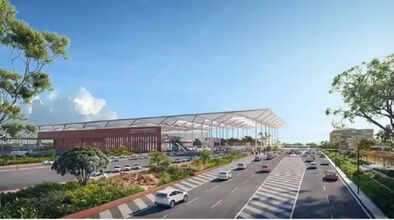Investment: Strict rules within 20 km of Jewar Airport; Know the pros and cons before investing..

There's great news for those living in Delhi-NCR. Noida International Airport (Jewar Airport) is set to open after a long wait, 40 days from today. Union Civil Aviation Minister K. Rammohan Naidu has announced that the airport will be inaugurated on October 30, 2025, with flights starting 45 days later, by the end of the year.
The key point is that demand for property around the airport has begun to rise as soon as it opens. However, the Yamuna Expressway Industrial Development Authority (YEIDA) has already implemented strict height restrictions for Jewar Airport, which are crucial for you to understand. You should also be aware of its advantages and disadvantages. Pradeep Mishra, founder of Oram Group, explains every detail about this. So let's understand:
Strict restrictions on construction within a 20-kilometer radius
Under the guidelines of the Airport Authority of India (AAI), there will now be strict restrictions on building construction within a 20-kilometer radius of the airport (Jewar Airport construction norms). This will directly impact investors in Delhi-NCR, especially Noida and Greater Noida. The AAI (AAI NOC requirement) has released a color-coded zoning map, which specifies building heights for each area.
Permission is mandatory for buildings taller than 15 meters
Any building taller than 15 meters will require mandatory approval through the NOCAS portal. However, any construction without permission within a 10-kilometer radius of the airport is strictly prohibited.
Restrictions on towers and tree plantations
Height restrictions will apply to every building within a 20-kilometer radius, whether residential, commercial, telecom towers, or tree plantations. The rules are particularly stringent in the airport's funnel area, where building heights up to 2% of the runway distance will be permitted.
In contrast, the UP Building Bylaws 2025 will apply to areas outside 20 kilometers. Roads wider than 45 meters have unlimited FAR and no height restrictions, making investment opportunities in these areas more attractive.
5 Benefits of the Jewar Airport
The biggest benefit is safety. These rules will prevent bird strikes, building collisions, and radar interference, ensuring safe airport operations.
Property values will increase because new buildings will be less easily constructed, leading to a premium in the price of existing, legal buildings.
Only quality development will take place, as every project will be required to obtain a NOC. This will reduce the risk of illegal colonies.
Government revenue will increase, revenue will be generated from NOC fees, clearance charges, and regulations, and planning will also improve.
The area's infrastructure will rapidly improve as the government focuses on roads, electricity, and connectivity for authorized projects.
5 Disadvantages of the Jewar Airport
Landowners will suffer losses because they will not be able to utilize their entire land. High-rise projects may be stalled.
There will be confusion among buyers and investors because the color-coded map and the NOC process are difficult to understand.
Developers' expenses will increase. NOC fees, surveys, and lengthy approval processes will make projects more expensive.
There will be a disparity between areas within and outside the 20-kilometer radius. Those outside will receive unlimited FAR exemptions, while those within will face restrictions.
Implementation will be challenging. The complexities of AAI guidelines, YEIDA approvals, and technical surveys will cost both time and money.
While the Jewar Airport is a golden opportunity for investors, it's important to understand every rule before investing in a property within a 20-kilometer radius. Otherwise, you could face significant losses in the future.
Disclaimer: This content has been sourced and edited from Dainik Jagran. While we have made modifications for clarity and presentation, the original content belongs to its respective authors and website. We do not claim ownership of the content.

